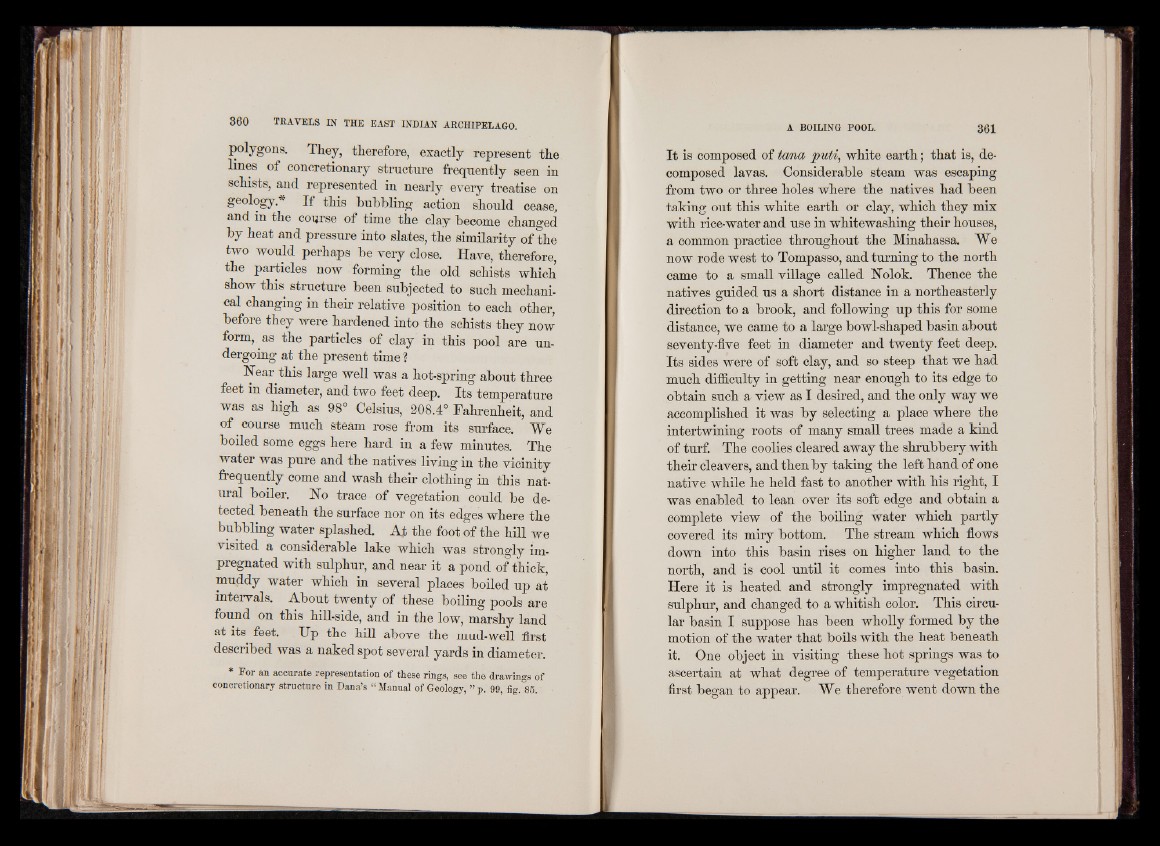
polygons. They, therefore, exactly represent the
lines of concretionary structure frequently seen in
schists, and represented in nearly every treatise on
geology.* If this bubbling action should cease,
and m the course of time the clay become changed
by heat and pressure into slates, the similarity of the
two would perhaps be very close. Have, therefore,
the particles now forming the old schists which
show this structure been subjected to such mechanical
changing in their relative position to each other,
before they were hardened into the schists they now
form, as the particles of clay in this pool are undergoing
at the present time ?
Hear this large well was a hot-spring about three
feet in diameter, and two feet deep. Its temperature
was as high as 98° Celsius, 208.4° Fahrenheit, and
of course much steam rose from its surface. We
boiled some eggs here hard in a few minutes. The
water was pure and the natives living in the vicinity
frequently come and wash their clothing in this natural
boiler. Ho trace of vegetation could be detected
beneath the surface nor on its edges where the
bubbling water splashed. Ajfc the foot of the hill we
visited a considerable lake which was strongly impregnated
with sulphur, and near it a pond of thick,
muddy water which in several places boiled up at
intervals. About twenty of these boiling pools are
found on this hill-side, and in the low, marshy land
at its feet. Up the hill above the mud-well first
described was a naked spot several yards in diameter.
For an accurate representation of these rings, see the drawings of
concretionary structure in Dana’s “ Manual of Geology, ” p. 99, fig. 85.
It is composed of ta/na puti, white earth; that is, decomposed
lavas. Considerable steam was escaping
from two or three holes where the natives had been
taking out this white earth or clay, which they mix
with rice-water and use in whitewashing their houses,
a common practice throughout the Minahassa. We
now rode west to Tompasso, and turning to the north
came to a small village called Holok. Thence the
natives guided us a short distance in a northeasterly
direction to a brook, and following up this for some
distance, we came to a large bowl-shaped basin about
seventy-five feet in diameter and twenty feet deep.
Its sides were of soft clay, and so steep that we had
much difficulty in getting near enough to its edge to
obtain such a view as I desired, and the only way we
accomplished it was by selecting a place where the
intertwining roots of many small trees made a kind
of turf. The coolies cleared away the shrubbery with
their cleavers, and then by taking the left hand of one
native while he held fast to another with his right, I
was enabled to lean over its soft edge and obtain a
complete view of the boiling water which partly
covered its miry bottom. The stream which flows
down into this basin rises on higher land to the
north, and is cool until it comes into this basin.
Here it is heated and strongly impregnated with
sulphur, and changed to a whitish color. This circular
basin I suppose has been wholly formed by the
motion of the water that boils with the heat beneath
it. One object in visiting these hot springs was to
ascertain at what degree of temperature vegetation
first began to appear. We therefore went down the